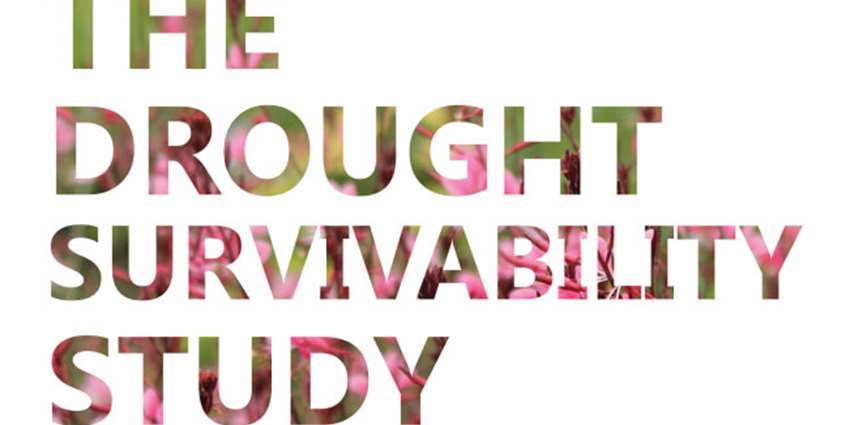What if there was a way to irrigate less but still have good-looking landscapes?
Thanks to research results recently published by the Texas A&M Institute of Renewable Natural Resources (IRNR) and the Texas Water Resources Institute (TWRI), homeowners and landscapers can now learn exactly how little water is needed by popular Central Texas ornamental plants to not only survive but thrive.
The drought survivability study, conducted in San Antonio throughout 2015, found that many ornamental plants popular in Central Texas landscapes only need half or less of the usual recommended irrigation amounts.
From popular pink and red knockout roses, to Esperanza shrubs with brilliant yellow blooms, to wide swaths of blue Grama grass blowing in the Hill Country breeze, Central Texas’ climate can sustain a wide variety of plants. The study demonstrated how 97 of those plant species common to the region fared when watered with various amounts of water over the course of 12 weeks.
Most of the study’s plants remained lush and healthy when watered in smaller amounts, and some remained healthy with zero irrigation.
“We wanted to find out how these popular plants would perform with less water and in drought-like conditions,” said Amy Uyen Truong, IRNR and TWRI research assistant. “The results can help not only those residents who want to reduce their outdoor water use without sacrificing an aesthetic landscape but also business owners and professional landscapers.”
Truong co-authored the report with Dr. Richard White, Texas A&M AgriLife Research turfgrass management scientist; Forrest Cobb, IRNR research assistant, and Dr. Roel Lopez, IRNR director. Results were recently published as Texas Water Resources Institute Technical Report-495.
Because of Central Texas’ variable weather and rainfall, and its history of prolonged periods of drought, it was important for the study to quantify how little water plants needed to survive droughts or watering limits, Truong said.
Outdoor residential water use ranges from 22 to 67 percent of total residential use in Texas, according to the Texas Water Development Board. “So, reducing outdoor water use could make a huge dent in the state’s water demand, especially during drought when peak water demand is especially high,” she said.
The study consisted of a 5,000-square-foot demonstration site, divided into four plots, each filled with all 97 of the plants being studied. After planting, a three-month establishment period of watering at recommended levels ensured that the plants were healthy and established.
“This establishment period is key to drought-tolerant landscape success,” Truong said.
For 12 weeks the plants in each of the four plots were then subjected to four different drought treatments: no water, and 20 percent, 40 percent and 60 percent of potential evapotranspiration (ETo). Potential evapotranspiration is the amount of water a plant loses every day, and 70 percent of ETo is the estimated average watering rate of residential landscapes in Texas, according to the Texas Water Development Board.
The study used a large movable roof to make the zero ETo plot possible, Truong said; the roof moved over that section of the study during rain.
“The difference between the 0-percent ETO plot and the 20-percent ETo plot was striking,” Truong said. “With just a little bit more water, we found that half of the plants were significantly more lush. Some plants don’t need much water to thrive.”
“Watering these plants with just 20 or 40 percent ETo, instead of the usual 70 percent, resulted in many plants remaining lush and aesthetically pleasing,” she said. “Multiply those potential water savings across the vast amounts of residential and commercial landscapes in Central Texas, and the savings would be significant.”
“Of the plant species tested in this study, 54 percent remained stable or lush at just 20 percent ETo,” Truong said.
Truong and the study’s other authors recommend planting groups of plants that have similar reactions to water-stress to help reduce water waste, avoid plant replacement costs and ensure aesthetic appeal.
“After an establishment period, plants such as Cenizo, Fall Astar, Gaura, Oleander and Mexican Feathergrass remained lush or stable with no additional water, and could work well together in a water-wise landscape,” she said.
In fact, 21 percent of the species tested could withstand a period of drought without any supplemental irrigation or rainfall, she said.
The study was supported by the two institutes, Texas A&M AgriLife Research, San Antonio Water System, the cities of Austin and Georgetown, and the San Antonio River Authority.
More than 50 local volunteers, many master gardeners and master naturalists, also helped make the study possible, Truong said. While helping plant plants and weed the plots, the volunteers got to see first-hand how the plants were performing with little water and many were interested in planting more drought-tolerant plants in their own landscapes, Truong said.
For more information, read the study’s report, or contact Truong at Uyen.Truong@ag.tamu.edu.

